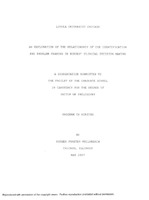Clinical reasoning in experienced nurses
View File(s)
- Author(s)
- Details
-
Barbara Simmons, PhD, Adjunct Faculty - Benedictine University
- Sigma Affiliation
- Lambda Upsilon at-Large
Visitor Statistics
Visits vs Downloads
Visitors - World Map
Top Visiting Countries
| Country | Visits |
|---|
Top Visiting Cities
| City | Visits |
|---|
Visits (last 6 months)
Downloads (last 6 months)
Popular Works for Simmons, Barbara by View
| Title | Page Views |
|---|
Popular Works for Simmons, Barbara by Download
| Title | Downloads |
|---|
View Citations
Citations
This qualitative descriptive study was designed to explore the cognitive strategies used by experienced nurses as they think about assessment findings on their assigned patients. As an essential component of nursing practice, clinical reasoning is used to assimilate information, analyze data, and make decisions regarding patient care. Changes in health care settings and patient acuity challenge nurses to make complex decisions under conditions of uncertainty and risk. With fewer expert nurses available to act as mentors, experienced nurses who are not yet experts must utilize varied reasoning strategies to care for acutely ill patients. Few studies of nurses' clinical reasoning have been conducted in a practice setting during actual patient care. Information processing theory provided the theoretical framework for the study. Fifteen experienced nurses were asked to ‘think aloud’ about their beginning shift assessments. An experienced nurse was defined as a registered nurse with no advanced degree or certification who had worked full time on a medical-surgical unit more than 2 years but less than 10 years. Think aloud data were audiotaped and transcribed. Three steps of protocol analysis were used to analyze the data. These included referring phrase, assertional, and script analysis. Referring phrase analysis organized data according to concepts. Assertional analysis identified the links that were made between concepts, and script analysis revealed the heuristics that nurses used while reasoning. The results of this study indicated that experienced nurses used a conceptual language to reason about patient assessments, linked these concepts together to make sense of the information, and consistently used heuristics to reason more quickly and efficiently. Secondary findings included support for the definition and model of clinical reasoning used in this study, as well as support for information processing theory as the underlying theoretical framework used by nurses. A serendipitous finding was that experienced nurses used reasoning strategies that have previously been identified only in experts. Results of this study have implication for practice, education, and further research. The classic work of Benner may need to be revisited in order to identify current skill levels in practice.
This dissertation has also been disseminated through the ProQuest Dissertations and Theses database. Dissertation/thesis number: 3039305; ProQuest document ID: 251667215. The author still retains copyright.
This item has not gone through this repository's peer-review process, but has been accepted by the indicated university or college in partial fulfillment of the requirements for the specified degree.
| Type | Dissertation |
| Acquisition | Proxy-submission |
| Review Type | None: Degree-based Submission |
| Format | Text-based Document |
| Evidence Level | Descriptive/Correlational |
| Research Approach | Qualitative Research |
| Keywords | Decision-Making; Problem-Solving; Clinical Reasoning |
| Grantor | Loyola University Chicago |
| Advisor | Lanuza, Dorothy; Hicks, Frank |
| Level | PhD |
| Year | 2002 |
All rights reserved by the author(s) and/or publisher(s) listed in this item record unless relinquished in whole or part by a rights notation or a Creative Commons License present in this item record.
All permission requests should be directed accordingly and not to the Sigma Repository.
All submitting authors or publishers have affirmed that when using material in their work where they do not own copyright, they have obtained permission of the copyright holder prior to submission and the rights holder has been acknowledged as necessary.
Related items
Showing items related by title, author, creator and subjects.
-
An exploration of the relationship of cue identification and problem framing in nurses' clinical decision making
Mullenbach, Kereen F.This qualitative descriptive study was designed to explore the relationship of cue identification and problem framing as part of the problem solving and decision making of medical surgical nurses as they thought-aloud while ... -
The effects of pattern recognition based simulation scenarios on symptom recognition of myocardial infarction, critical thinking, clinical decision-making, and clinical judgment in nursing students
Walsh, Susan A.In the United States nearly 1 million annual new and recurrent myocardial infarctions (MI) occur with 10% of patients hospitalized with MI having unrecognized ischemic symptoms. Inexperienced nurses are expected to accurately ... -
Testing and refining an integrated ethically-driven environmental model of clinical decision-making in emergency settings
Wolf, Lisa AdamsThe purpose of the study was to explore the relationship between multiple variables within a model of critical thinking and moral reasoning that support and refine the elements that significantly correlate with accuracy ... -
The effects of instructional methodology and learning style on problem solving in baccalaureate nursing students enrolled in an introductory pharmacology course
Hill, Karen B.The primary purpose of this quantitative study was threefold: (1) to compare the effectiveness of two instructional methods of teaching on transferring problem solving; (2) to identify the effect a student's learning style ... -
Proxy decision-making and dementia care: Exploring decision-makers' thinking using construal level theory
Convey, Helen M.; Holt, Janet; Summers, Barbara (2017-06-06)Purpose: Dementia is a syndrome which affects the individual’s ability to make decisions and to undertake everyday activities (ADI, 2015; WHO, 2012). A range of neurodegenerative diseases (including Alzheimer’s ...





